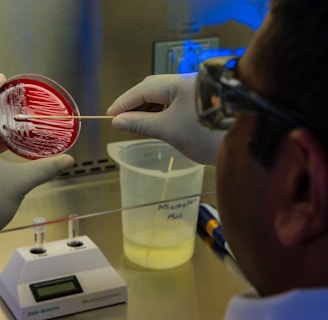WHY THERE IS A CHALLENGE IN PRESERVATION FOR MICROBIAL STRAINS
Microbiology
Write your text here...
Write your text here...
Microbial strain preservation presents a formidable challenge within the microbiology community. Many individuals encounter difficulties in effectively preserving and reviving the microbial strains. In this blog post, we will explore some of the key challenges associated with microbial culture preservation and propose potential solutions to address these issues.
Is Microbial Culture Preservation an Intricate Endeavor that Demands Specialized Expertise?
The short answer is yes; microbial culture preservation is indeed a complex task. It goes beyond simple culture identification; it necessitates regular purity checks to ensure that the strains remain uncontaminated and viable.
To successfully navigate this complexity, a comprehensive skill set that is compliant with current Good Manufacturing Practices (cGMP) is essential. Additionally, users must engage in annual training to maintain their competence in performing critical assays, a requirement that extends to the preservation of microbial cultures as well.
Moreover, users are responsible for designing and executing validation and verification protocols for the data related to their in-house culture preservation techniques. This process involves conducting a thorough gap analysis of the methodologies employed, as well as understanding the complete life-cycle of culture preservation, revival, and reconstitution of microbial strains.
Understanding Microbial Culture Passage Numbers?
To comprehend the significance of passage numbers, we first need to define what a passage is. In formal terms, a passage refers to the subculturing of an active microbial culture into a fresh growth medium. For example, when an active microbial strain is at the first passage, subculturing will elevate it to the second passage, and each subsequent subculture will further increase the passage number.
It is important to note, as stated by the American Type Culture Collection (ATCC), that if a microbial strain or reference strain is either freeze-dried or frozen, the process of subculturing from these reference strains does not count as an additional passage until it is first revived from its frozen state.
According to the Harmonized Pharmacopeia, which encompasses guidelines from authoritative bodies such as the USP (United States Pharmacopeia), EP (European Pharmacopeia), JP (Japanese Pharmacopeia), and the World Health Organization (WHO), etc., it is recommended that the microbial cultures employed for challenge testing should not exceed the fifth passage. This is primarily due to the heightened risk of mutations and alterations in the morphological and phenotypic characteristics of the microbial strains beyond this point.
Strategies for mitigating the impact of Factors that May Modify Microbial Strains
To prevent the potential modifications of microbial strains, the following strategies can be employed:
Risk Assessment: Systematic evaluation to identify and mitigate risks associated with microbial culture preservation.
Validation and Verification: Ensuring that the methods used are robust and yield reliable results over time
Always follow the manufacturer's instruction
Temperature Control: Maintaining optimal temperatures during preservation to prevent strain alteration.
Preservation Techniques: Employing scientifically backed preservation methods that minimize the chance for mutations.
Training and Education: Ensuring that all personnel involved in microbial culture preservation are well-trained and up to date with the latest practices and protocols.
Overall, a thorough understanding of these challenges and the implementation of effective strategies can greatly improve the preservation and revival of microbial strains in laboratory settings.
We have discussed some of the key factors that may influence the microbial culture growth and remedies. Although, we will recommend all the viewers to use their scientific acumen before implementing any suggestion mentioned.
Author
Ashutosh Mohan
Founder & CEO, Consult MicroBio
Certified Six Sigma Black Belt, QMS Auditor (IS0 9001:2016)


